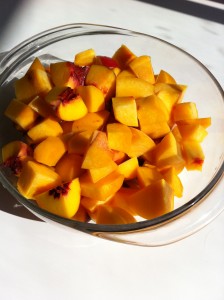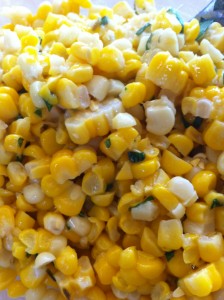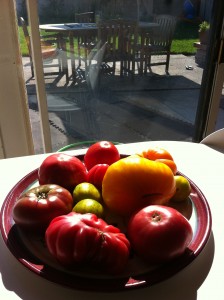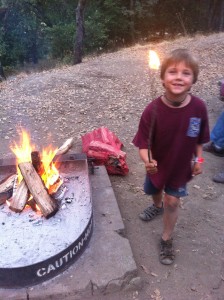not much more al fresco dining
Even though the temperatures here are still summerlike, and our markets are still full of piles of plums, rainbow swaths of tomatoes, giant bouquets of cilantro and basil, I am facing the end of summer and all that comes with it. This weekend, I will slow roast dozens of pounds of early girls, zip their jammy goodness into bags, and freeze them for the winter rains. I’ll continue to make double batches of pesto as long as I can, freezing half and hoping the stash will last until March. Other than that, our summer food will be gone.
Cling peaches; waiting to be drenched in cream and brown sugar for the kids; in Prosecco for the adults
This is the way it should be.
Eating seasonally has become the paramount virtue at our table. It’s more important than organic. It’s more important than family dinner. It’s more important than getting my kids in the kitchen or dragging them to the farmers’ market. We’ve done all that, and we still do all that. Sometimes. Now that Ella and Finn are older, they have their own ideas about things, and they just don’t always want to be in the kitchen. Most of the time, they’d rather climb the orange tree than juice its fruit. They’d rather kick the soccer ball into the fence than harvest the tomatoes growing along it. And they’re a lot more interested in the chocolate croissants than another peach sample on Saturday mornings. Can you blame them? Ella has been to over 400 farmers markets in her life. She’s 9. She gets it.
summer corn with butter and basil
Most weekend mornings, she’d rather stay home and finish building that new metropolis she and Finn started. They have an open invitation to the kitchen. They can mix up smoothies or kidtinis when the (nonalcoholic) spirit moves them. But bedtime is more important than eating with dad. So we will have family dinner on the weekends. They won’t leave the house without knowing how to chop an onion or read a recipe or buy their own food.
Still, there is one, unwavering constant: here, in this very lucky climate, we eat what grows in season. If it’s not in the farmers market, we don’t buy it. What we eat is tied to the cycle of the year, and reminds us of a specific time and place. It’s the one, true constant of our food life.
the end of the heirlooms
The kids mourn the loss of stone fruit, but they can’t wait for apples. They gobble up the blueberries, but are enchanted by the first knobby, ruby red, pomegranates. Sharing these things, like the fleeting perfume of pineapple guavas or winters’ crunchy Hachiya persimmons, brings us together. We have shared desires. We know it’s the dead of winter when our oranges are ready to eat. We know spring has come when I bring home the first favas. In fall, shelling a new crop of walnuts is like digging for gold. These things are our common memory. These things bring us to the table. We don’t have a large family. We don’t have an elaborate kitchen. We don’t cook together all the time. We don’t have a whole lot of traditions or generations-old family recipes, or a rich cultural legacy. What we do have: things to remember and things to look forward to and things to eat right now. We make the most of what is in front of us, in the pantry, or the refrigerator, or on the counter. We “watch what it is, though it fades away” and it’s a lesson in food, and family, and, yes, life. Persimmons come, peaches go. Padrons give way to pomegranates. These are the things I think they’ll remember about growing up in California. That, and maybe cooking with sticks.






Melissa
September 29, 2011 @ 1:47 pm
I left home not knowing how to chop an onion 😉 Nice post, as usual! xo
Learning To Eat » Archivio » Fall Food
October 4, 2011 @ 10:29 am
[…] just like that, summer is over. We knew it was coming, but that definitive moment, when you look at a tomato and think, I’ve had enough had not yet […]